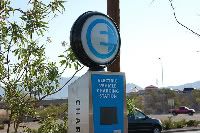Aeroponics: Boon to Organically Grown Produce
While I’m in the studio next week shooting another round of videos, I plan to highlight 2GreenEnergy’s relationship with Waters Wheel, a company with a bright vision of the future of organic, local-grown farming. The secret sauce here, if there is one, is a clever, extremely inexpensive approach to aeroponics, growing produce in a minimum of space, using a tower (pictured here) in which the root systems receive a carefully maintained balance of air, water, and nutrients. (more…)







